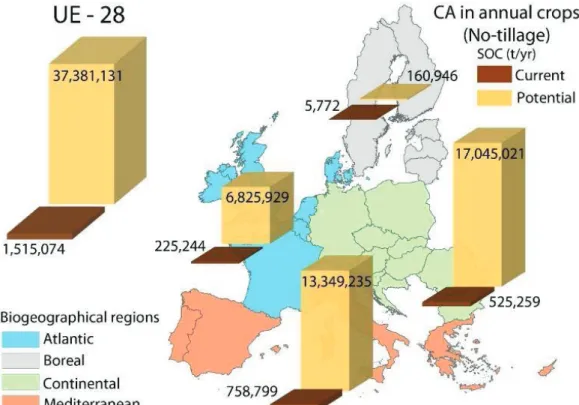67
67
67
MITIGATION OF CLIMATE CHANGE THROUGH CONSERVATION
AGRICULTURE IN EUROPE
G. Basch1,2*, E.J. González-Sánchez1,3,4, J. Gil-Ribes3,4, R. Ordóñez-Fernández5,
O. Veroz-González3, P. Triviño-Tarradas1, R. Carbonell-Bojollo5, F. Márquez-García4,
M. Gómez-Ariza3, A. Holgado-Cabrera1, M. Moreno-García1
1European Conservation Agriculture Federation (ECAF). Rond Point Schumann 6 Box 5. Brussels (Belgium) www.ecaf.org
2Institute of Mediterranean and Environmental Sciences. Universidade de Évora, Évora, Portugal. 3Asociación Española Agricultura de Conservación Suelos Vivos. Ifapa Alameda del Obispo. Córdoba, Spain. www.agriculturadeconservacion.org
4Departamento Ingeniería Rural, Etsiam, Universidad De Córdoba, GI AGR 126. Mecanización y Tecnología Rural. Campus de Rabanales, Córdoba, Spain. www.uco.es/cemtro
5Área de Producción Ecológica y Recursos Naturales. IFAPA. Consejería de Agricultura, Pesca y Desarrollo Rural. Junta de Andalucía.
*Corresponding author: gbasch@ecaf.org ABSTRACT
Agriculture and climate change are closely related. In this communication, the European Conservation Agriculture Federation (ECAF) presents how the European agricultural sector can respond to climate change through Conservation Agriculture (CA). It is based on the outcomes and the realization of several European (LIFE) public-funded projects based on the assessment of CA performance in Europe, and on a literature review on the topic. In terms of contribution, approximately 10% of greenhouse gases (GHGs) globally emitted come from the European Union (EU). Within the GHGs emitted in Europe, around 10% derive from agriculture. In order to reduce these emissions the 21st meeting of the Conference of the Parties
(COP21) and the 11th meeting of the Conference of the Parties serving as the meeting of the Parties to
the Kyoto Protocol (CMP) was held at the end of 2015 in Paris. It concluded with the adoption of a historic agreement to combat climate change and promote measures and investments for a low-carbon, resilient and sustainable future, the so-called Paris Agreement. Scientifi c studies, carried out in diff erent European biogeographic regions and countries, agree that the less soil is tilled, the more carbon is sequestered and stored in it. These studies show that, during several years of Conservation Agriculture, it is possible to sequester large amounts of CO2 per hectare and year in soils, when compared to systems based on soil tillage. In relation to conventional tillage systems the implementation of CA in EU-28 countries in both annual and perennial crops could result in an annual sequestration of almost 190 millions of tons CO2 as soil organic carbon. The amount of CO2 sequestered into the soil through the application of the CA would contribute signifi cantly to reach the targets committed in Paris Agreement by 2030. Considering accepted European emission reduction targets, carbon sequestration that could take place on farmland under Conservation Agriculture would amount to 22% of reductions committed in all diff use emission sectors by 2030, which corresponds to 10% of total annual diff use emissions. This would allow for some fl exibility in the reduction of emissions in other sectors such as housing or transport.
KEYWORDS: climate change mitigation, Conservation Agriculture, Best Management Practices, SOC, no-till, groundcovers.
68
68
68
1
stto 4
thof August 2017
Rosary - Argentina
BACKGROUNDAgriculture and climate change are closely related. In terms of contribution, approximately 10% of greenhouse gases (GHGs) globally emitted come from the European Union (EU). Within the GHGs emitted in Europe, around 10% derive from agriculture. In this short communication, the European Conservation Agriculture Federation (ECAF) presents how the European agricultural sector can respond to climate change through Conservation Agriculture (CA). It is based on the outcomes of several public-funded European LIFE projects on the assessment of CA performance in Europe, and on a literature review on the topic. The full paper (González-Sánchez et al., 2017) can be downloaded from ECAF’s website (www.ecaf.org).
APPLICATIONS AND IMPLICATIONS FOR CONSERVATION AGRICULTURE
Today, in order to achieve sustainability in agriculture a multidimensional approach is essential to attain a balance, or best compromise, between preservation and improvement of the environment, social equity and economic viability, and therefore improve the welfare of society. It is widely recognized that this can only be achieved if natural resources are maintained or even improved, i.e. used responsibly and effi ciently. Not only in agriculture, soil is a key resource as it mediates a wide range of ecosystem services both provisioning, regulating and supporting services. To this end, soil quality, and in particular the amount of organic carbon stored in it are essential. Scientifi c studies carried out in diff erent agro-ecological regions and countries agree that the less soil is tilled, the more carbon is sequestered and stored in it. Plants absorb carbon dioxide from the air and transform it through the process of photosynthesis into organic carbon. This organic carbon becomes the source for soil organic matter, contributing thus to an enhanced soil fertility and to an improved productive capacity. On the other hand, any action aimed at saving energy and fuel, such as reducing the number of tillage operations, optimizing the use of agricultural inputs and proper execution of operations, directly reduces emissions of greenhouse gases. Therefore, a sustainable agricultural system that responds to these requirements is of particular importance: Conservation Agriculture.
DESCRIPTION
Diff erent studies in Europe show that during several years of application of CA principles it is possible to sequester large amounts of CO2 per hectare and year in both annual and permanent crops, when compared to tillage-based cropping systems. Average sequestration rates per biogeographical region in Europe are summarized in Table 1.
Based on these assumptions the estimation for EU-28 countries of the potential soil organic carbon (SOC) sequestration through the adoption of CA in annual crops when compared to conventional tillage systems is given in Figure 1 for the diff erent biogeographical regions in Europe.
In relation to CA in permanent crops (groundcovers), there are no offi cial data for Europe as a whole. Due to that, the data on the current adoption of this practice derive from reports of the European national associations of Conservation Agriculture. Although scientifi c data for carbon sequestration are only available for the Mediterranean biogeographic region (except France), we present a calculation of the C sequestration potential in permanent crops for EU-28 in Figure 2, based on a considered conservative annual sequestration rate of 0.4 t ha-1yr-1 (Table 1).
69
69
69
81,9(56,'$'(
Food and Agriculture Organization of the United Nations
With technical support of
In order to quantify the CO2 emission reduction achievable through the sequestration of organic C in the soil and not released through the microbiological oxidation processes of organic matter, we are using the ratio of 3.7 tons of CO2 that are generated from 1 ton of organic C. Therefore, taking into account the increase in soil organic matter (SOM) observed in CA systems (both annual crops and groundcovers in permanent crops) in comparison to the management systems based on conventional tillage, it is possible to calculate the total CO2 emission off set potential through the implementation of CA in Europe (Table 2). The amount of CO2 sequestered in the soil through the application of the CA, would reach the targets committed by 2030 in the Paris Agreement (UN, 2017) with greater ease. Considering overall European fi gures, carbon sequestration that could take place on farm land under Conservation Agriculture would help achieve around 22% of the necessary reductions in the non-ETS sectors by 2030, and almost 10% of the total emissions still allowed in the non-ETS sectors. This achievement would give the signing member countries some margin in the emission reduction in other sectors such as housing or transport.
Table 1. Average carbon sequestration rates in annual and permanent crops by biogeographical region.
considered conservative annual sequestration rate of 0.4 t ha
yr
(Table 1).
In order to quantify the CO
2emission reduction achievable through the
sequestration of organic C in the soil and not released through the microbiological
oxidation processes of organic matter, we are using the ratio of 3.7 tons of CO
2that
are generated from 1 ton of organic C. Therefore, taking into account the increase in
soil organic matter (SOM) observed in CA systems (both annual crops and
groundcovers in permanent crops) in comparison to the management systems based
on conventional tillage, it is possible to calculate the total CO
2emission offset potential
through the implementation of CA in Europe (Table 2). The amount of CO
2sequestered
in the soil through the application of the CA, would reach the targets committed by
2030 in the Paris Agreement (UN, 2017) with greater ease. Considering overall
European figures, carbon sequestration that could take place on farm land under
Conservation Agriculture would help achieve around 22% of the necessary reductions
in the non-ETS sectors by 2030, and almost 10% of the total emissions still allowed in
the non-ETS sectors. This achievement would give the signing member countries some
margin in the emission reduction in other sectors such as housing or transport.
Table 1. Average carbon sequestration rates in annual and permanent crops by
biogeographical region.
Biogeographical region
Crop type Atlantic Boreal Continental Mediterranean
Annual Increase of soil
organic carbon (t ha-1 yr-1)
0.32 0.02 0.42 0.81
Permanent 0.40 ND 0.40 1.30
70
70
70
1
stto 4
thof August 2017
Rosary - Argentina
Figure 1. Current and potential SOC fixed by CA in annual crops compared to systems
based on conventional soil tillage in EU-28 and for the different biogeographical
regions in Europe.
Figure 2. Current and potential SOC fixed by groundcovers compared to systems based
on soil tillage in EU-28 and in the different biogeographical regions.
Figure 1. Current and potential SOC fi xed by CA in annual crops compared to systems based on conventional soil tillage in EU-28 and for the diff erent biogeographical regions in Europe.
Figure 1. Current and potential SOC fixed by CA in annual crops compared to systems
based on conventional soil tillage in EU-28 and for the different biogeographical
regions in Europe.
Figure 2. Current and potential SOC fixed by groundcovers compared to systems based
on soil tillage in EU-28 and in the different biogeographical regions.
Figure 2. Current and potential SOC fi xed by groundcovers compared to systems based on soil tillage in EU-28 and in the diff erent biogeographical regions.
71
71
71
Table 2. Current and potential fi xation of COTable 2. Current and potential fixation of CO2 in Europe.2 in Europe.
Biogeographi cal region Current CO2 fixation through CA (t yr-1) Total Potential CO2 fixation through CA (t yr-1)
Remaining Potential for CO2 fixation through CA (Potential - current) (t yr-1) Austria Continental 43,731 2,019,403 1,975,672 Belgium Atlantic 320 782,291 781,971 Bulgaria Continental 25,470 5,145,996 5,120,526 Croatia Continental 28,619 1,432,719 1,404,101 Cyprus Mediterranean 803 341,213 340,410 Czech Republic Continental 63,010 3,752,510 3,689,499 Denmark Atlantic 2,959 2,632,794 2,629,835 Estonia Boreal 3,090 42,435 39,345 Finland Boreal 14,667 140,265 125,599 France Atlantic 220,000 14,358,615 14,138,615 Germany Continental 232,617 17,723,982 17,491,365 Greece Mediterranean 2,309,258 9,729,155 7,419,897 Hungary Continental 103,051 5,809,954 5,706,902 Ireland Atlantic 2,367 1,186,900 1,184,533 Italy Mediterranean 1,322,806 26,374,586 25,051,780 Latvia Boreal 832 80,788 79,956 Lithuania Boreal 1,414 156,173 154,759 Luxembourg Continental 679 96,532 95,853 Malta Mediterranean 0 23,611 23,611 Netherlands Atlantic 8,700 874,935 866,234 Poland Continental 603,650 15,391,891 14,788,241 Portugal Mediterranean 205,142 6,382,238 6,177,096 Romania Continental 901,191 11,916,910 11,015,719 Slovakia Continental 43,024 2,052,459 2,009,435 Slovenia Continental 3,828 309,713 305,885 Spain Mediterranean 9,134,893 52,947,794 43,812,901 Sweden Boreal 1,160 170,474 169,314 United Kingdom Atlantic 591,548 7,203,670 6,612,122 Total Europe 15,868,829 189,080,005 173,211,176 REFERENCES
González-Sánchez, E.J., M. Moreno-García, A. Kassam, A. Holgado-Cabrera, P. Triviño-Tarradas, R. Carbonell-Bojollo, M. Pisante, O. Veroz-González and G. Basch. 2017. Conservation Agriculture: Making Climate Change Mitigation and Adaptation Real in Europe. European Conservation Agriculture Federation (ECAF).
UN, 2017. The Paris Agreement. Available in:
http://unfccc.int/paris_agreement/items/9485.php
REFERENCES
González-Sánchez, E.J., M. Moreno-García, A. Kassam, A. Holgado-Cabrera, P. Triviño-Tarradas, R. Carbonell-Bojollo, M. Pisante, O. Veroz-González and G. Basch. 2017. Conservation Agriculture: Making Climate Change Mitigation and Adaptation Real in Europe. European Conservation Agriculture Federation (ECAF). UN, 2017. The Paris Agreement. Available in: http://unfccc.int/paris_agreement/items/9485.php


